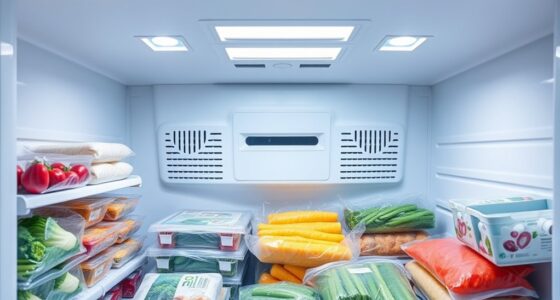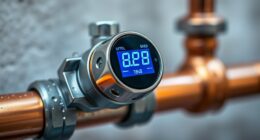To keep produce fresh, use high humidity for leafy greens and moisture-rich vegetables, which need moisture to stay crisp. Switch to low humidity for fruits like apples, pears, and melons, which tolerate drier conditions and last longer this way. Properly managing these settings helps extend produce life and reduces waste. If you want to learn how to maximize your crisper drawer’s effectiveness and avoid common mistakes, keep exploring for more tips.
Key Takeaways
- High humidity settings are ideal for leafy greens and moisture-rich vegetables to keep them crisp and fresh.
- Low humidity settings work best for fruits like apples and pears to slow ripening and prevent mold.
- Adjust crisper humidity based on produce type to extend shelf life and maintain quality.
- Properly drying produce before storage and avoiding overcrowding helps optimize humidity conditions.
- Regularly monitor and clean drawers to ensure effective humidity control and prevent spoilage.
Understanding Crisper Drawer Humidity Controls

Understanding how crisper drawer humidity controls work is key to keeping your produce fresh longer. These controls regulate airflow by adjusting vents, which either trap moisture or allow gases to escape. When you set the drawer to high humidity, vents close, trapping moisture and gases inside to keep high-moisture vegetables crisp. Conversely, low humidity settings open vents, allowing excess moisture and ethylene gas to escape, which slows ripening and spoilage. The moisture released by your produce also influences humidity levels, making manual adjustments essential for ideal storage. Most crisper drawers feature sliders or switches to toggle between high and low settings. These mechanisms help create a controlled environment, mimicking natural conditions that preserve produce quality and extend shelf life. Proper use maximizes freshness and minimizes waste. Adjusting these settings correctly enhances the overall effectiveness of your crisper drawer by maintaining optimal humidity levels. Additionally, understanding climatic factors can further improve produce preservation. Recognizing the importance of airflow management can help you optimize storage conditions for different types of produce.
When to Use High Humidity for Fresh Produce
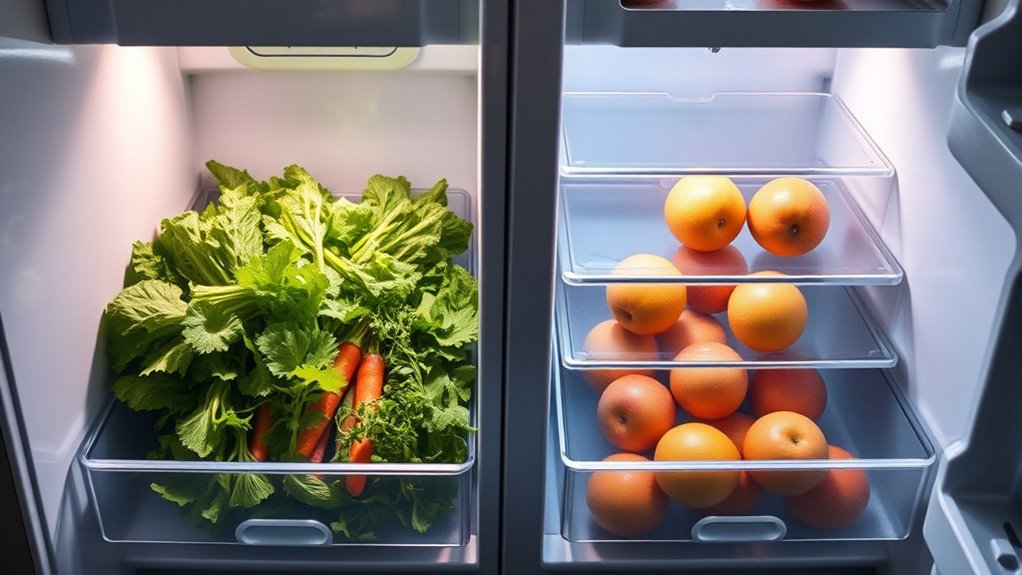
Use the high humidity setting when storing leafy greens like lettuce or spinach to keep them crisp longer. It’s also ideal for moisture-rich vegetables such as broccoli, cucumbers, and celery that tend to wilt quickly. By maintaining a moist environment, you can extend freshness and reduce waste for these produce types. Controlling airflow and humidity levels helps create the optimal storage environment for these items.
Best for Leafy Greens
Have you ever wondered when to switch your refrigerator’s crisper drawer to high humidity for ideal freshness? Use high humidity when storing leafy greens like lettuce, spinach, or kale. This setting keeps moisture in, reducing wilting and maintaining crispness. It’s perfect for produce that arrives moist or is sensitive to dehydration. To visualize, here’s how high humidity benefits different greens:
| Produce | Benefits | Storage Tip |
|---|---|---|
| Lettuce | Keeps leaves crisp | Pat dry before storing |
| Spinach | Prevents wilting | Use perforated bags |
| Kale | Maintains freshness | Don’t overcrowd |
| Herbs | Preserves delicate leaves | Lightly dry before storage |
| Broccoli | Keeps florets firm | Use high humidity drawer |
High humidity traps moisture, prolonging freshness and reducing waste. Additionally, maintaining proper humidity levels helps preserve nutrients and extend the shelf life of your produce. Proper humidity control is essential for optimal produce preservation, ensuring your greens stay fresh longer.
Ideal for Moisture-Rich Vegetables
When storing moisture-rich vegetables like cucumbers and bell peppers, high humidity settings are essential for keeping them crisp and fresh. High humidity traps moisture inside the crisper drawer, preventing these delicate vegetables from drying out quickly. Restricting airflow helps retain the natural moisture content, which is crucial for maintaining their texture and flavor. This environment is especially beneficial for produce that is ethylene-sensitive, as it slows ripening and spoilage. Use high humidity when storing thin-skinned vegetables that lose moisture fast. Properly adjusting your crisper drawer’s humidity setting prolongs freshness and reduces waste. Keep in mind that moisture-rich vegetables benefit most from a high humidity environment, ensuring they stay crisp, flavorful, and ready to eat longer.
Ideal Items for Low Humidity Storage
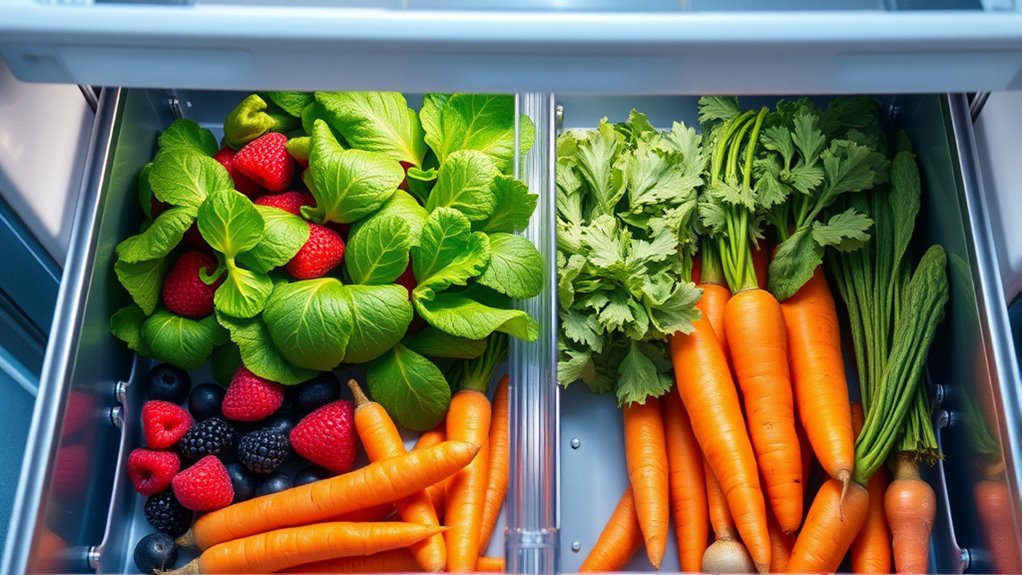
If you want to keep your low-humidity drawer effective, focus on storing fruits like apples, pears, and melons, which do well without excess moisture. Remember that some fruits, such as apples and pears, produce ethylene gas that can speed up ripening or spoilage if not managed properly. By selecting the right items and controlling ethylene emission, you can prevent mold and decay, extending the freshness of your produce. Additionally, using proper storage techniques can help maintain optimal conditions and prolong freshness. Incorporating holistic approaches to health and wellness by choosing suitable storage methods supports overall food safety and quality.
Fruits That Ethylene Emission
Certain fruits emit ethylene gas at high levels, making their storage in low humidity crisper drawers essential to slow ripening and prevent spoilage. Apples produce very high ethylene, so keep them separate from other fruits to avoid speeding up ripening. Ripe bananas emit medium to high ethylene, benefiting from low humidity to slow their progression. Pears and peaches also generate high ethylene; storing them in low humidity helps control over-ripening. Melons like cantaloupe produce medium ethylene and stay fresher longer in low humidity. By placing these fruits in low humidity drawers, you reduce their metabolic activity, delaying ripening and decay. Proper separation and humidity control are crucial for extending shelf life and maintaining quality in your refrigerator. Humidity levels play a vital role in managing ethylene effects and preserving fruit freshness. Additionally, understanding ethylene emission can help optimize storage conditions and extend the lifespan of your produce.
Preventing Mold and Decay
Proper storage in low humidity crisper drawers not only slows ripening but also helps prevent mold and decay. By reducing moisture, you create an environment less favorable for mold growth, especially for thick-skinned produce. Low humidity also allows ethylene gas to escape, preventing over-ripening and spoilage. To maximize benefits, choose items like apples, avocados, melons, nectarines, and bell peppers for low humidity storage. Use adjustable vents or breathable containers to improve airflow and keep produce dry. Regularly inspect and clean your crisper drawer to avoid mold buildup. Proper ventilation and rotation help ensure even airflow around your produce. Additionally, controlling humidity levels is an essential nutritional information aspect that supports food preservation and reduces waste. Incorporating automation in food storage can further optimize humidity control and freshness.
How Proper Humidity Extends Produce Freshness
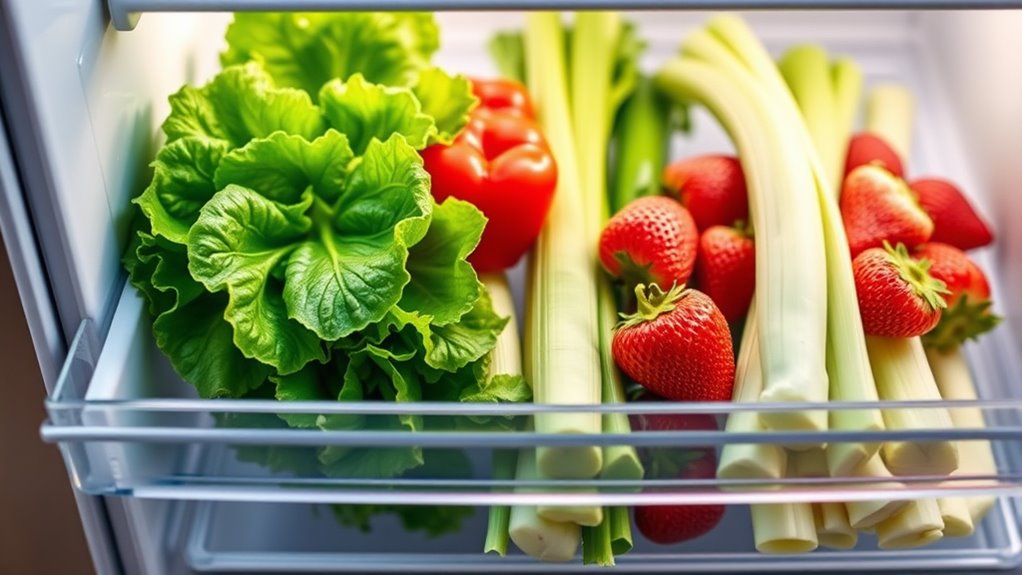
Have you ever wondered how adjusting the humidity in your crisper drawer keeps produce fresh longer? When you set the humidity correctly, you control moisture levels, which directly impacts produce’s lifespan. High humidity settings trap moisture inside, ideal for leafy greens and cucumbers that lose water quickly. This environment helps preserve crunch, color, and texture, delaying wilting and spoilage. Conversely, low humidity settings allow excess moisture and ethylene gas to escape, slowing ripening and preventing mold in fruits like apples and melons. Proper humidity management reduces dehydration and decay, extending freshness. By tailoring the environment to each produce type, you minimize spoilage and waste. Maintaining the right humidity also influences color accuracy and overall quality, ensuring your fruits and vegetables stay crisp, flavorful, and nutritious for longer periods. Additionally, understanding humidity control techniques can further optimize produce preservation.
Tips for Managing Crisper Drawer Settings Effectively
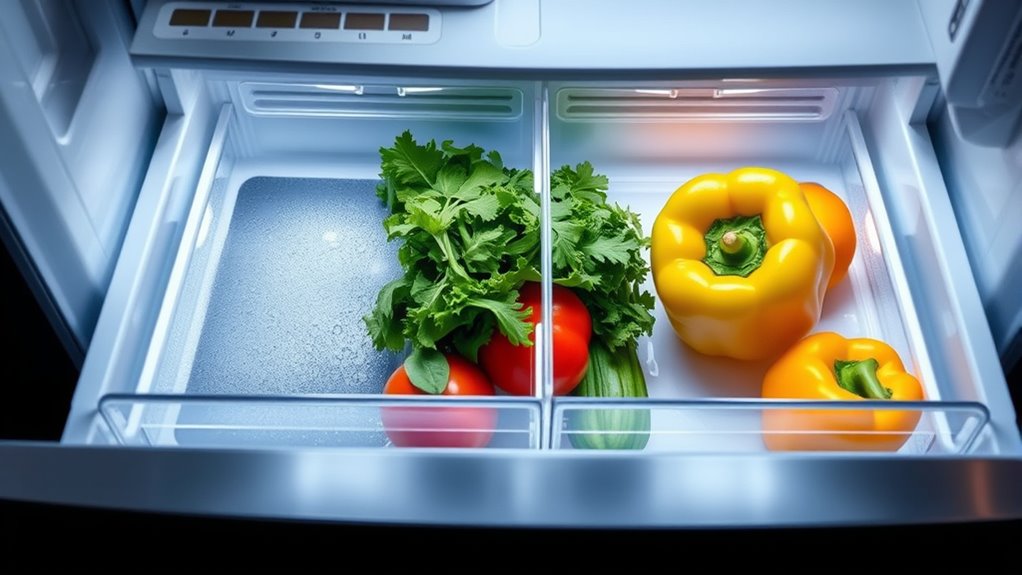
Managing your crisper drawer settings effectively requires understanding how to adjust airflow controls to keep produce fresh. Use the vent sliders or dials to switch between high and low humidity based on what you store. Keep leafy greens and moisture-sensitive vegetables in the high humidity drawer to prevent wilting. Place ethylene-producing fruits like apples or melons in the low humidity section to help gases escape and slow spoilage. Regularly check and adjust the controls if produce shows signs of wilting or over-ripening. Clean the drawers with hot water and mild detergent regularly to prevent mold and odors, and dry thoroughly before reinserting produce. Avoid mid-position settings, as they can cause uneven airflow, reducing shelf life. Proper crisper drawer management helps maximize freshness and minimize waste. Additionally, understanding the Home Cinema technologies can enhance your overall kitchen and entertainment space, creating a more integrated environment. Monitoring and quick adjustments help maximize freshness and minimize waste.
Common Mistakes to Avoid With Humidity Settings
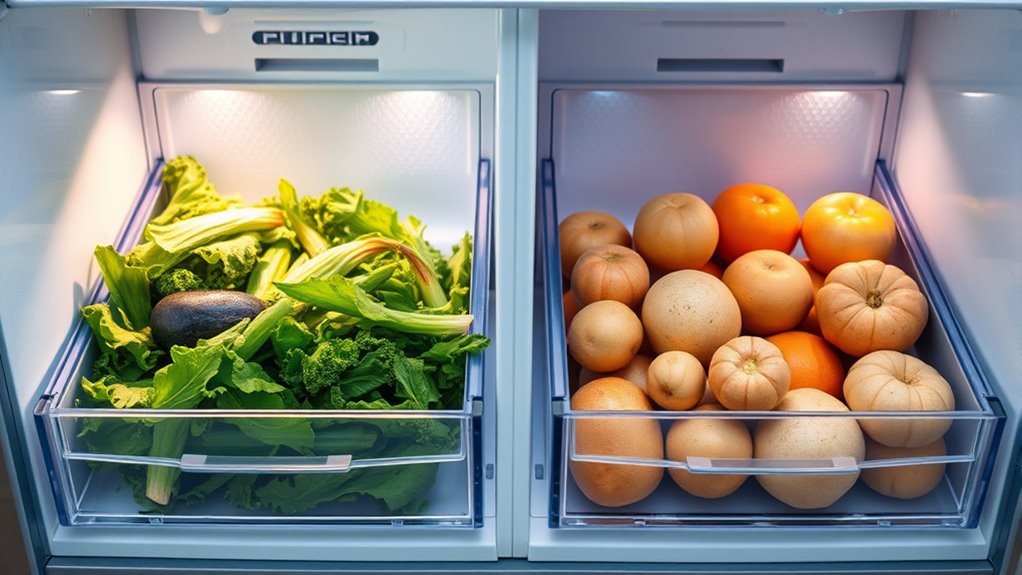
One common mistake is setting the humidity level incorrectly for the type of produce you’re storing. Using high humidity for ethylene-producing fruits, like apples, traps gases and speeds spoilage. Conversely, low humidity for leafy greens causes wilting and quick decay. Putting wet produce directly into drawers fosters mold and bacterial growth. Not drying items first worsens moisture issues. Additionally, filtration systems can influence moisture levels and airflow within the drawers, affecting freshness. Avoid misusing drawers for non-food items—raw meat or dairy can cause cross-contamination and odors. Failing to adjust humidity as produce ripens accelerates spoilage. Overcrowding restricts airflow, leading to uneven humidity and quick rot. Proper humidity management is essential to keep produce fresh longer. Here’s a quick guide:
| Produce Type | Ideal Humidity | Common Mistakes |
|---|---|---|
| Leafy greens | High | Storing wet or low-humidity greens |
| Ethylene emitters | High | Mixing with sensitive vegetables |
| Fruits with pits | Low | Excess moisture and mold |
| Ripe fruits | Low | Not reducing humidity when ripe |
Frequently Asked Questions
Can I Store the Same Produce in Both Drawers Simultaneously?
You shouldn’t store the same produce in both drawers simultaneously because their moisture needs differ. Leafy greens and herbs thrive in high humidity to stay crisp, while fruits like apples and pears prefer low humidity to slow spoilage. Mixing them can cause premature wilting or rotting. To keep everything fresh, segregate produce by their humidity requirements and store them separately, ensuring each item remains in ideal condition longer.
How Often Should I Adjust Humidity Settings for Optimal Storage?
You should rarely need to adjust the humidity settings once you’ve got it right, but surprise, surprise — your produce may need a tweak here and there. Check your fruits and veggies regularly, especially if they start to wilt or spoil prematurely. When you notice changes, switch the humidity to suit their needs. It’s all about listening to your produce’s subtle hints and avoiding a spoilage catastrophe.
Do Humidity Settings Affect the Overall Refrigerator Temperature?
Humidity settings don’t affect your refrigerator’s overall temperature. When you switch between high and low humidity, you’re only changing airflow around your produce, not the fridge’s cooling cycle. The temperature remains consistent because it’s controlled separately by the thermostat and cooling system. So, if you want to adjust the fridge’s temperature, you should use the main thermostat, not the humidity controls in the crisper drawers.
Are There Specific Fruits or Vegetables That Need Both High and Low Humidity?
Yes, some fruits and vegetables need both high and low humidity, but not at the same time. For example, leafy greens and herbs thrive in high humidity to stay crisp, while apples and pears prefer low humidity to slow ripening. You should store these items separately in different crisper drawers, adjusting the humidity settings accordingly. This approach helps maximize freshness and extends their shelf life effectively.
What Signs Indicate My Crisper Drawer Humidity Is Improperly Set?
Think of your crisper drawer like a delicate greenhouse. If you see droplets inside, your humidity’s too high—like overwatering your plants—and produce can rot. If leaves are wilting or turning brown, it’s too dry, like a desert. Soggy or moldy produce signals excess moisture, while shriveled, crispy items show dryness. Pay attention to these signs to keep your produce fresh, just like a well-cared-for garden.
Conclusion
Now that you know how to use your crisper drawer’s humidity settings, you can keep your produce fresher longer. Are you ready to take control of your fridge and reduce waste? By adjusting the humidity correctly, you’ll enjoy crisp vegetables and juicy fruits at their best. So, why not give it a try today and see the difference it makes in your kitchen? Freshness is just a setting away!




